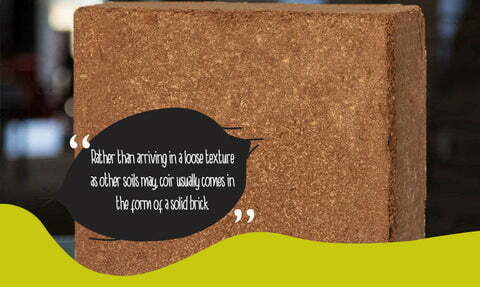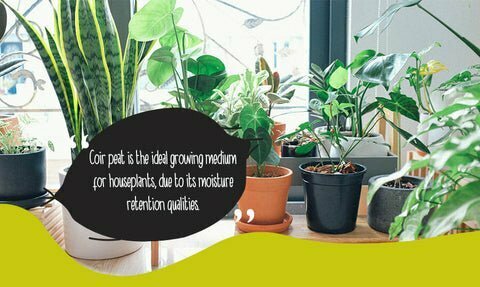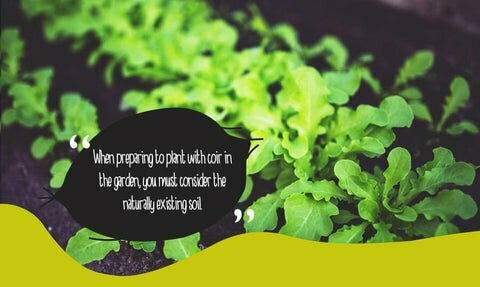How to Prepare Coco Coir: Garden Use vs Indoor Plants
Coco coir is fast becoming a favourite growing medium, with many a satisfied gardener cultivating thriving greenery in this sustainable peat moss alternative. This article will guide you through how to prepare coco coir bricks in order to help you achieve the best possible results,
HOW TO PREPARE COCO COIR
A naturally occurring by-product of coconuts, coco coir will not arrive to you in the same way as other growing mediums. Rather than arriving in a loose texture, coir usually comes in the form of a solid brick. Whether intended for outdoor garden use or indoor plants, coconut coir must be properly prepared before planting.
Although it is possible to purchase pre-prepared coconut coir, this is often more expensive. Additionally, as coco coir is favoured for its sustainable qualities, purchasing a product that is larger, and therefore harder and less economical to ship, is counterproductive.
HYDRATING COCO COIR BRICKS
In order to use your coco coir, it must first be hydrated.
- Put the brick in a large container – remember that the brick will expand five to seven times once hydrated, so ensure you choose a large enough container.
- Cover the brick with warm water. Bricks can be bought in several different weights – a good rule of thumb when deciding how much water to add is 4/5 gallons per 5 kilo brick.
- Allow the water to absorb for at least 15 minutes.
- Once absorbed, fluff the coco coir up until it resembles the ideal soil-like consistency.

ADDING NUTRIENTS TO COCO COIR
Perhaps the most common cause for budding gardeners not getting on with coco peat is the lack of naturally existing nutrients. If no essential nutrients are added during the preparation stage, you may find that your plants do not thrive as well as they may in other growing mediums such as peat moss.
As coco coir grows in popularity, suppliers are becoming more attuned to the needs of their customers, with many now offering pre-mixed coir that already contains nutrients. For example, Coco and Coir’s Coco Boost contains NPK – a mixture of nitrogen, phosphorous and potassium for optimum plant growth.
If you choose a coco coir variant that is not supplied with nutrients, it is essential you add your own when preparing. The ideal additional nutrients will vary from plant to plant – refer to specific growing instructions in order to choose correctly.
USING COCO COIR IN THE GARDEN VS INDOORS
The beauty of coco peat is that it is perfect for growing all manner of plants, flowers and vegetables: be it indoors, in the garden or within a hydroponic system. Although coco coir will be prepared using the same technique identified above, for both indoor and outdoor plants, as with all soil alternatives it must be treated differently depending on where you are growing.

USING COCO COIR FOR HOUSEPLANTS
Coir peat is the ideal growing medium for houseplants, due to excellent moisture retention and good aerobic qualities. Indoor plants require a soil that is loose and open in texture, in order to ensure that water can disperse freely, and air can circulate. However, too loose a structure and the water will flow straight through, preventing the roots from absorbing any moisture at all.
When you prepare coco coir for indoor plants, the main thing to remember is that you do not need as much product compared with garden use. For indoor planting, we’d recommend opting for the smallest coco peat brick available. The denseness of a coco coir brick means that it is impossible to break apart before it is hydrated – it must be hydrated whole.
If you do find that you have excess coir after potting house plants, remember that coco peat can be recycled, and stored for several months.
When growing houseplants in coco coir, the ‘primary’ nutrients, as contained in Coco Boost, will need to be added during preparation.
COCO COIR AND INDOOR SUCCULENTS
Whilst coco coir is an excellent medium for almost all houseplants, it will require extra care when used to pot arid soil succulents, such as cacti. Given the water-retentive characteristic of coco coir, care must be exercised to ensure the plants do not receive too much moisture. As long as you are careful not to overwater and allowing sufficient drying time, coco coir can make an excellent substrate for growing indoor succulents.
When you prepare coco coir for succulents, it must be mixed with a coarser material in order to replicate its natural environment. Pumice, perlite or sand are all suitable.

USING COCO COIR IN THE GARDEN
Coco coir is an excellent peat moss alternative for garden use. Once prepared, intervals between watering can be longer due to coco coir’s excellent water retention. Coir will also naturally improve moisture drainage – ideal for those of you living in areas that receive heavy rainfall.
When preparing to plant with coir in the garden, you must consider the naturally existing soil in your garden and how coir can be mixed with them in order to create the ideal growing environment. For example, clay soil is often too dense to grow vegetables or other outdoor plants. Mixing clay soil with coco coir before planting will create a much lighter texture, allowing roots to take hold and thrive.
If your garden’s soil is sandy, you may find it is too dry to plant in. The addition of coco peat will significantly improve your garden’s moisture retention.
As with indoor use, the addition of vital nutrients is an essential part of the preparation stage. Each plant will have specific requirements: double check the exact needs to ensure optimum health.
COCO PEAT FOR A HYDROPONIC SYSTEM
Hydroponic gardening refers to the growing of plants without any soil and can be utilised both indoors and outdoors. As coir is technically a soil alternative, it is compatible with hydroponic gardening and can yield positive results.
When preparing coir for a hydroponic system, it is essential that it is properly rinsed. Being highly absorbent means coir can be prone to retaining high levels of salt. Excess salt can be fatal in a hydroponic system – a thorough rinse with fresh water prior to planting will help prevent this.
When buying coco peat from Coco & Coir, you will find that it arrives pre-washed and with its EC levels reduced, making it immediately ready for use in any environment – including hydrophonics.










